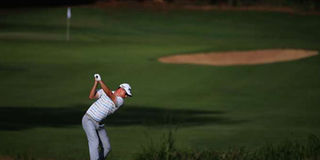Obstructions in all shapes, sizes

Paul Apyan hits a shot on the 11th fairway during Round Three of the Flor De Cana Open on September 3, 2016 in Guacalito de la Isla, Nicaragua. PHOTO | SEAN M. HAFFEY |
What you need to know:
- In the Rules of Golf, obstructions are defined as anything artificial...
Lately I have been having some very pleasant dreams. In my dreams, I have managed to hit the little white ball accurately to the fairway.
“Accurate” in this context does not necessarily mean “straight”. It just means that I have found the short grass on the fairways away from the hazards and the frightful situations I often find myself in the roughs. The progress from the teeing ground to the putting green has been pleasant; that is in my dreams.
Sadly, this has not been the case away from my nap and on the golf course. I constantly find myself in areas of the course that are less trodden. Areas from where to reach the putting green one is forced to take a devious route.
These routes will have obstructions that are never seen by those that play the course, as it should be. I am not the only one who is beset with this problem. All golfers, from time immemorial, have had to suffer from the consequences of an ill-struck or ill-aimed stroke.
In the Rules of Golf, obstructions are defined as anything artificial... However, sometimes we are impeded by natural things such as logs and stones.
These are known as “Loose Impediments”. These are a topic for another day. In the old times, various attempts were made to list obstructions.
In 1851 the only ones mentioned were clothes and washing tubs. Clearly, there were some housewives who chose to dry their laundry on fairways. The rule on obstructions was: “When a ball is on clothes or within a club-length of a washing-tub, the clothes may be drawn from under the ball and tub may be removed”.
This must have angered the housewives who most likely found the laundry soiled by the begrimed hands of the golfers. They most likely didn’t place the clothes back as they focused on their next shot. In 1888 the outcries of the housewives were heeded and the rule was changed thus: “When a ball lies on clothes the ball may be lifted and dropped behind without penalty”.
In 1891, the Rule was again changed to be more in line with what we have today. The Rule allowed the removal of movable obstructions or the removal of a ball lying on or touching an immovable obstruction. In the years that followed, there were attempts to have a list of items that would be considered as obstructions.
These included flagsticks, guide posts, vehicle and many others. The USGA made a bold move of listing every possible obstruction after the Second World War.
This verbosity was short lived. In 1951, the R&A and USGA got together and adopted a guide to the procedure to be adopted according to whether the obstruction was movable or not. Today the Rules of Golf state that an obstruction is considered movable if it may be moved without unreasonable effort, without unduly delaying play and without causing damage.
A moveable obstruction may be removed from anywhere on the course including the hazards. Should the ball move in the process of removing the moveable obstruction, there is no penalty and the ball must be replaced. When the ball lies partly on a piece of paper (which is an unnatural item), if the removal of the paper causes the ball to move, the ball must be replaced.
If the ball lies entirely on the paper and no part of it touches the course, and the player takes the option of removing the paper, the ball must, through the green, be dropped and placed on the putting green after the removal of the paper.
Free relief is available if the golfer finds that an immovable obstruction interferes with play of a shot. Relief is however not obtainable for all situations where the lie of the ball, area of intended swing or stance is impeded by an immovable obstruction.
Take an example of the water pipes that are found within the water hazards on holes number six and eleven at Royal Nairobi Golf Club. Whereas the water pipes are artificial, one must not get relief if the ball lies in a water hazard. The same thing applies to the bridge on hole number 18 at Karen Country Club which is partly within the water hazard.
So if like me you find yourself with a decorous swing and unrelated hands, knowing how to deal with obstructions may come in handy.
However, it is more important to have skills in skirting bushes and ducking under low hanging branches. Those will be the things that will most likely be in your way.
The author is a KGU Executive




